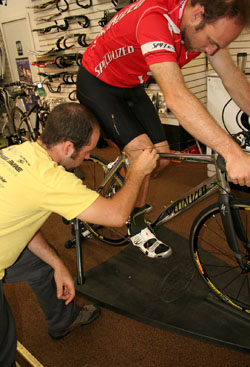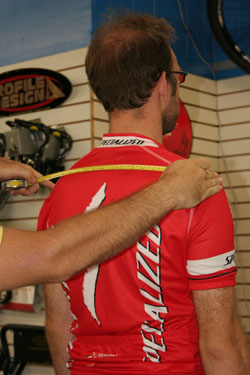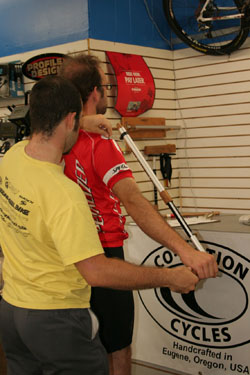Bike Fitting
While specific methodologies vary, fitting a bike to a person’s anatomy can be broken down into a three-step process of measuring the body, calculating the measurements, and applying the results to the bike’s hardware. Qualitative assessments of the rider’s cycling style, physical shape, competitive aspiration and other facets are made by the fitter, and that criteria is also factored in with the measurements for the final fitting.

Bike fitting can be broken down into three steps...
Photo by Jeffrey G. Frane
The end result should be a bike that is custom fit to your body’s most subtle bends, angles and anatomical quirks. Advantages to a well-fit bike may include increased power and performance, injury prevention and a more comfortable ride, including, in the best cases, the elimination of saddle sores, numb hands, achy back muscles and overextended knees.
To test out these claims, I recently visited Freewheel Bike, a mid-size shop in Minneapolis, for a fitting. The shop charged $100 for the fitting session, which lasted about two hours and included all the aforementioned body evaluation and bike adjustments.

A well-fit bike can increase power and prevent injury...
Photo by Jeffrey G. Frane
Freewheel Bike uses a system called the Grand Master Fit Kit, which is a package of esoteric rulers and measuring devices plus a computer software program to calculate the results. My fitting started with a questionnaire to determine my rider type and athletic motivation. This was followed by a series of measurements to my body and then the final tinkering and tweaking of the bike.
Your body makes contact with a bike in three places -- the pedals, the saddle and the handlebars -- and a fitting focuses almost exclusively on those areas. Changing the height of the saddle, for example, allows the fitter to position your legs for optimal efficiency during a pedal stroke. By adjusting the handlebar stem, the angle of your back and the extension of your arms is corrected to maximize comfort and aerodynamics.

Bike fit prices range from $80-$150...
Photo by Jeffrey G. Frane
During my fitting session, Freewheel Bike's head fitter, Tyler Denniston, positioned my bike in a stationary spin trainer device to let me pedal naturally inside the store. After making some initial adjustments to the saddle and handlebar stem based off the Grand Master Fit Kit's software calculations, Denniston sat back and watched me pedal for a few minutes.
After this evaluation, Denniston switched the stem out for one that was a few centimeters shorter. He then made micro adjustments to the saddle and stem as well as the triathlon-style extension bars on my Specialized Transition Comp bike.
My primary concern with the fitting was increased performance. As such, Denniston adjusted my bike to maximize pedal power and aerodynamics. The final custom fit had me aggressively tucked for speed, but positioned so that I was not crunched up or slouched. My spine and torso were set in good posture to allow my lungs to fill completely with air, and my legs were unencumbered to efficiently spin the cranks for endless miles on the road.
Custom bike fittings are offered at hundreds of bike shops around the country, with prices ranging form $80 to $150 or more, depending on the program. Be prepared to pay more if the shop recommends switching out a component or two in order to maximize your exact fit on the bike.


 Subscribe to Stephen's RSS Feed
Subscribe to Stephen's RSS Feed

4 Comments:
Did you feel it was money well spent?
If you ride a lot of road, then yeah. I got fit right before I bucked up my training for an Ironman. It was crucial to be streamlined and perfectly fit to the bike for an event like that.
For mountain bikers, it's not so important. You want to fit to your mountain bike, but it does not have to be so exact, as you're standing up, sitting down, leaning, etc., while riding off trail.
Thanks Stephen.
Because of the price, this bike fitting is for people who frequently ride bikes, as I do. The participants in the Tour de France will benefit greatly from this, as do people of unusual proportions.
Post a Comment
<< Home